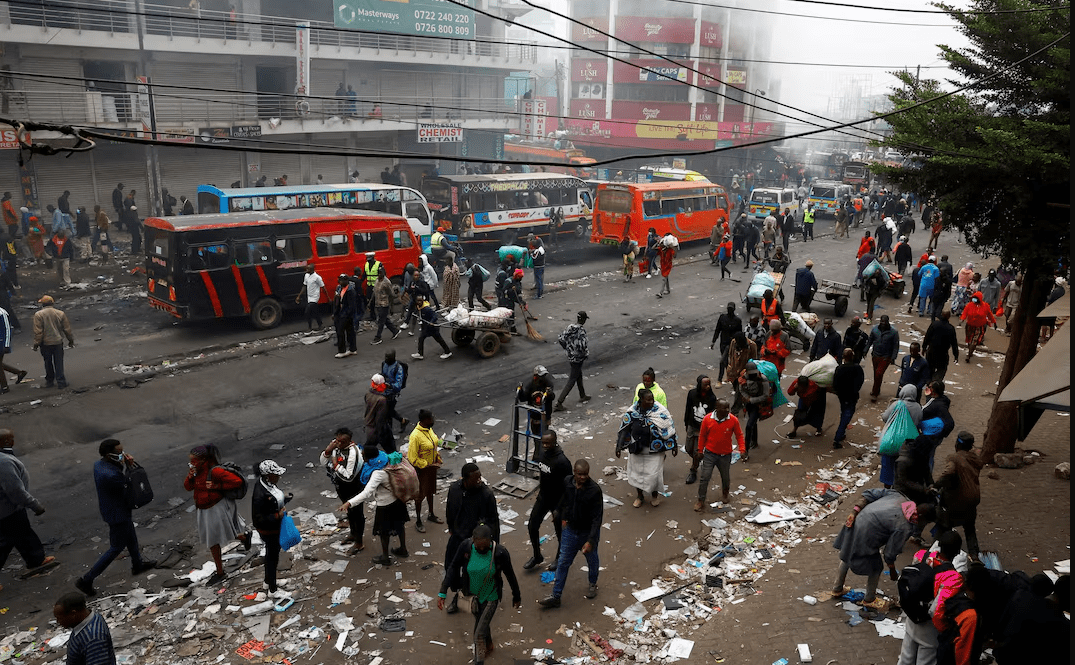Facebook Twitter (X) Instagram Somali Magazine - People's Magazine
Kenyans clean up the wreckage left behind after a wave of violent protests swept through Nairobi and other towns, leaving at least 16 people dead and dozens of businesses destroyed. The demonstrations, held to mark the first anniversary of the deadly 2024 Gen Z-led protests, quickly spiraled into chaos as looters and arsonists took advantage of the unrest, torching buildings and ransacking shops across 27 counties.
In downtown Nairobi, smoke still billowed from at least 10 buildings on Thursday morning as shop owners, county workers, and volunteers began the painstaking task of clearing debris and salvaging what little remained. Among the hardest hit was Musa House near the OTC roundabout, where a fire gutted several businesses overnight. Traders who had just restocked their shops stood in disbelief, some in tears, as they assessed the damage.
“I just restocked days ago. I didn’t know this would happen. I don’t know where to start from,” said Susan Wanjiru, a mobile phone dealer who lost over KSh800,000 worth of inventory. Nearby, shopkeeper Josephine Apondi recounted how looters made off with electronics worth KSh2 million. “Things are so tough in our country right now. Sometimes we come from morning until evening and don’t sell anything. And to think this is something you’ve invested in for so long,” she said.
The protests were sparked by the recent death of blogger Albert Ojwang, who was allegedly beaten while in police custody. His death reignited public anger over police brutality and lack of accountability, especially among Kenya’s youth. Demonstrators took to the streets in Nairobi, Kisumu, Mombasa, and Nakuru, demanding justice and reforms.
Police responded with tear gas and water cannons, but the situation quickly escalated. In Nairobi’s CBD, masked individuals infiltrated the protests, smashing windows, looting electronics stores, and setting buildings ablaze. Amnesty Kenya reported that all 16 fatalities were caused by gunshot wounds, allegedly inflicted by police officers. The police have yet to issue an official statement on the casualties.

In the aftermath, Nairobi County workers were seen sweeping streets littered with broken glass, burnt debris, and tear gas canisters. Mask vendors did brisk business as residents navigated the lingering fumes. Some traders salvaged metal and charred goods from their shops, while others simply stood in silence, overwhelmed by the scale of destruction.
The violence extended beyond the capital. In 26 other counties, similar scenes played out—looted supermarkets, torched government offices, and vandalized public transport vehicles. In one harrowing incident, a group of women preparing to travel for overseas jobs were trapped on the third floor of a burning building near Koja Roundabout. They were rescued by firefighters, though several fainted from smoke inhalation.
Despite the devastation, many Kenyans are calling for dialogue and accountability. “Look at everything they burnt. Please, government, try talking to the Gen Z. Sit down and talk with them,” pleaded Ibrahim Hamisi, owner of one of the torched buildings.
As the country begins to rebuild, the protests have reignited debate over governance, youth disenfranchisement, and the role of law enforcement. Prosecutors have already approved murder charges against six individuals, including three police officers, in connection with Ojwang’s death.
While cleanup efforts continue, the scars left behind—both physical and emotional—serve as a stark reminder of the urgent need for reform and reconciliation.

